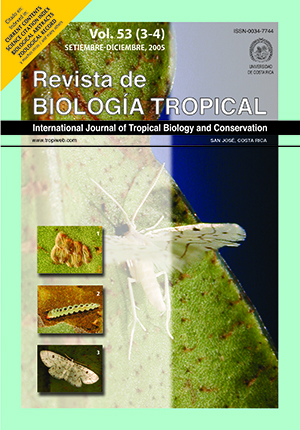Abstract
Fecal samples of 102 howler monkeys (Alouatta palliata) from several sites of Costa Rica were studied for intestinal parasites. The zones studied were: Central Valley (San Ramón, Alajuela), Central Pacific (Chomes and Manuel Antonio National Park, Puntarenas), North Pacific (Palo Verde Park and Playa Potrero, Guanacaste), Chira Island in the Nicoya Gulf and Caribean area (Cahuita, Limón). Animals were anesthetized with dards containing Telazol in order to collect the fecal material; some monkeys defecated spontaneously and others by direct stimulation. Samples were studied in saline solution (0.85%) and a Iodine solution, or stained with Haematoxylin. The material was also cultured in Dobell culture medium to determine the presence of amoeba and flagellates. Strongyloides, Controrchis, Trypanoxyuris genera were found in 3.4% of the samples. In addition 16.7% to 80% of the animals showed protozoa infection with Endolimax, Entamoeba, Trichomonas and Giardia. It is discussed the relationships of parasite infection with environmental conditions, animal population and human presence, specially in the monkey conservation programs point of view.
References
Anderson, R.M. 1979. Parasite pathogenicity and the depression of host population equilibria. Nature 279: 150-152.
Burrows, R.B. 1955. Endamoeba polecki infections in man. Am. J. Hyg. 162: 156-157.
Clarke, M.R., C.M. Crockett, E.L. Zucker & M.E. Zandícar- Ruiz. 2002. Mantled howler population of Hacienda La Pacífica, Costa Rica, between 1991 and 1998: Effects of deforestation. Am. J. Primatology 56: 155-163.
Clarke, M.R., D.A. Collins & E.L. Zucker. 2002. Responses to deforestation in a group of mantled howlers (Alouatta palliata) in Costa Rica. Int. J. Primatology. 23: 365-381.
Daszak, P., A.A. Cunningham & A.D. Hyatt. 2000. Emerging infectious diseases of wildlife-treats to biodiversity and human health. Science 287: 443-449.
IACUC, 1998. IACUC guidelines for the care and use of live vertebrate animals. Institutional Animal Care and Use Committee. Appendix F. (También disponible en línea: http://WWW.unmc.edu/Education/Animal/ guide/iacuc-GUIDELINES.pdf )
Gilbert, F.F. & D.G. Dodds. 1978. The philosophy and practice of wildlife management. Robert E. Krieger, Malabar, Florida, EEUU.
Glander, K.E. L..M. Fedigan, L. Fedigan & C. Chapman. 1991. Field Methods for Capture and Measurement of Three Monkey Species in Costa Rica. Fol. Primatol. 57: 70-82.
Gozalo, A.C. & M. Tantaleán. 1996. Parasitic Protozoa in Neotropical primates. Lab. Primate Newsletter 35: 1-7.
Jiménez-Quirós, O. & R. Brenes. 1957. Helmintos de la República de Costa Rica. V. Sobre la validez del género de Controrchis Price, 1928 (Trematoda, Dicrocoeliidae) y descripción de Controrchis caballeroi n. sp. Rev. Biol. Trop. 5: 103-121.
Jiménez-Quirós, O & R. Brenes. 1958. Nota sobre el tremátodo Controrchis caballeroi Jiménez y Brenes, 1957. Rev. Biol. Trop. 6: 189-190.
May, R.M. 1988. Conservation and Disease. Conserv. Biol. 2: 28-30.
Nassar, E., V. Pereira & T. Vodovoz. 2003. Medicina de la conservación en el estudio de poblaciones naturales de primates en Colombia. Primatol. Nuevo Mundo 2003: 239-252.
Nunn, C.L., S. Altizer, K.E. Jones & W. Sechrest. 2003. Comparative Tests of parasite species richness in Primates. Amer. Nat. 162: 597-614.
Rodríguez-Ortíz, B., L. García-Prieto, & G. Pérez-Ponce de León. 2004. Checklist of the helminth parasites of vertebrates in Costa Rica. Rev. Biol. Trop. 52: 313-354.
Sargeaunt, P.G., J.E. Williams & D.M. Jones. 1982. Electrophoretic Isoenzyme patterns of Entamoeba histolytica and Entamoeba chattoni in Primate survey. J. Protozool. 29: 136-139.
Scott, M.E. 1988. The impact of infection and disease on animal populations: implications for conservation biology. Conserv. Biol. 2: 40-56.
Stoner, K.E. 1996. Prevalence and intensity of intestinal parasites in mantled howling monkeys (Alouatta palliata) in northeastern Costa Rica: implications for conservation biology. Conserv. Biol. 10-2: 539-546.
Stuart, M.D., L.L. Greenspan, K.E. Glander & M.R. Clarke. 1990. Coprological survey of parasites of wild mantled howling monkeys, Alouatta palliata palliata. J. Wildlife Dis. 26: 547-549.
Stuart, M.D., V. Pendergast, S. Rumfelt, S. Pierberg, L. Greenspan, K.E. Glander & M.R. Clarke. 1998. Parasites of wild howlers (Alouatta spp.). Int. J. Primatol. 19: 493-512.
Villalobos, F., A.A. Valerio & A.P. Retana. 2004. A phylogeny of howler monkeys (Cebidae: Alouatta) based on mitochondrial, chromosomal and morphological data. Rev. Biol. Trop. 52: 665-677.
Zaldívar, M.E., O. Rocha, K.E. Glander, G. Aguilar, A.S. Huertas, R. Sánchez & G. Wong. 2004. Distribution, ecology, life history, genetic variation, and risk of extinction of nonhuman primates from Costa Rica. Rev. Biol. Trop. 52: 679-693.
##plugins.facebook.comentarios##

This work is licensed under a Creative Commons Attribution 4.0 International License.
Copyright (c) 2005 Revista de Biología Tropical


